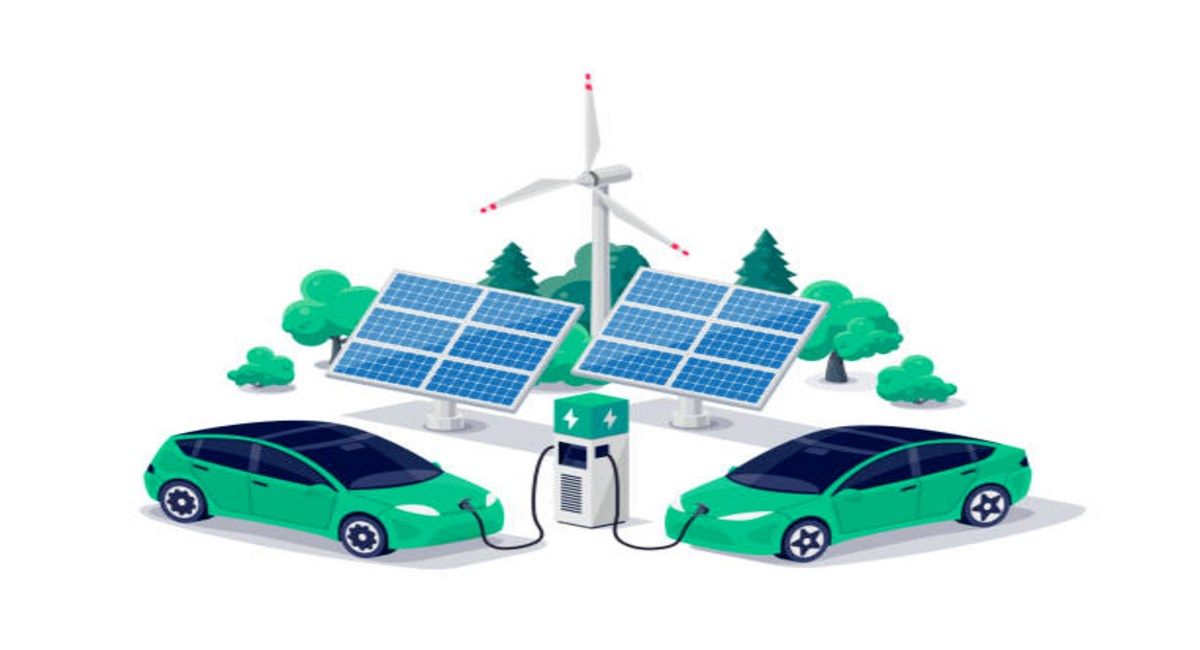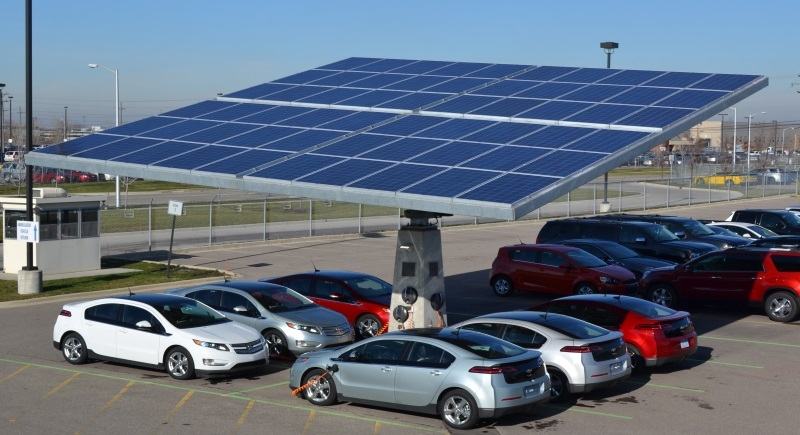How Much Solar Energy Is Needed To Charge An EV

Introduction:
If you drive an electric vehicle (EV) or want to get one, there's a strong chance you'll look into installing an EV charging station at your home. Home charging connectors allow EV owners to charge their vehicles without having to find a public charging station. Because there aren't nearly as many public EV charging stations as there are public petrol stations, owners must occasionally build their own.
The energy used by at-home charging stations is drawn from the existing electrical grid. The cost of utilizing this power is the same as the cost of using ordinary home electricity, and given that an electric car can store a substantial quantity of energy, it may be fairly expensive. This is why combining a charging station with a solar panel system is an excellent choice for both EV and solar panel owners.
To determine how many solar panels are required to power your electric vehicle, consider numerous aspects, such as the size of your EV battery, the efficiency of your panels, the type of hardware, and so on.
Solar Panel And EV Charging System:
The combination of a solar panel system and an EV charging station offers various advantages and is a cost-effective method to create and consume solar energy. This sort of configuration is required if you want to set up a solar panel system that can generate enough energy to power your electric automobile.
Solar inverters are a critical component of this puzzle. Before most of your electronics and appliances can use the solar energy you create, it must be converted from direct current (DC) to alternating current (AC). This is also true for using solar energy to power your electric vehicle.
Finally, the charging port will be built and linked to the inverter so that it may draw power and transmit it to the battery of the electric vehicle.
How Many Solar Panels Does It Take To Charge An EV?
The number of panels required will be determined by the size of your electric car's battery. In this scenario, though, let us consider the regular Tesla Model S with a 75 kWh battery.
First, we must examine the quantity of energy produced by a single solar panel. A solar panel's energy production is determined by its material, size, efficiency, and a few other criteria.
A typical 250-watt solar panel will generate 30–42.5 kWh of alternating current each month. To be safe, let's pick the bare minimum to get a ballpark figure.
If a single low-cost solar panel can provide about 1 kWh of AC electricity each day, that means you'd need a whopping 75 solar panels to power your Tesla Model S from 0 to 100 percent capacity every day.

Fortunately, the average motorist drives 37 miles each day, which equates to around 12 kWh of power. As a result, 12 solar panels would be a more realistic quantity. Remember that this is a conservative estimate, so if your solar panels are efficient, the number of panels may be reduced even more. Furthermore, if you travel less than 30 miles each day, the number of necessary panels will be considerably reduced. This figure is quite feasible for potential solar panel owners and EV owners because most solar panel systems comprise 25 to 30 solar panels.
How Long Would It Take To Charge An Electric Car With A Solar Panel?
The time it takes to charge an electric car using solar panels is determined by the electric car and the voltage of the solar panels. For this example, we used the average automotive battery size of 54kWh for this example, and the typical household solar system is roughly 4kW. A panel of this size will produce 3,400 kWh per year, or 9 kWh per day.
According to this estimate, it would take six 4kW solar panels a day to charge an electric car battery to full capacity. However, given that the typical driver drives 37 miles per day, it is doubtful that you will ever need to charge all day or for the whole day to attain maximum battery capability. 37 miles per day equates to around 12 kWh of electricity. Most solar panel systems comprise 25 to 30 solar panels, implying that the real charging time of a day would be much shorter.
How Many Solar Panels Required To Charge A Tesla?

Tesla and SolarCity, electric cars and solar panels – a two-front war waged against grid reliance and energy dependence. It's not only possible to charge your Tesla with solar power, it's encouraged. An electric vehicle such as a Tesla can serve as battery storage for solar energy. Find out what solar panels cost in your area in 2022. The merger brings together two of the world's leading solutions to emissions reduction under one roof.
Now that Tesla has been established as a clean energy behemoth, it's time to explain what this means for the carbon-conscious homeowner. How do you connect solar panels to an electric vehicle? How much electricity will it take to charge a Tesla Model S? The time it takes to charge a Tesla depends on a few factors, such as the model and type of connection. A short trip 25 miles each way would require roughly 17 kWh of energy, while the energy needed to run errands might only require 2 or 3 kWh. To charge a Model 3 on a standard, three-pronged NEMA 5-15 outlet with a 120 volt 15 amp breaker, it would take roughly 5 days if the battery had a zero charge initially.
Lastly, It would take roughly 10 solar panels to charge a Tesla.
How Much Solar Energy Is Required To Charge An EV Battery?
There are several ways to think about the power that an EV battery demands. The first consideration is the charge per mile traveled, which is commonly represented in kilowatt-hours per 100 miles driven (kWh/100 mi). Another method to analyze the amount of power necessary to run an EV is to examine the amount of electricity required to completely charge the vehicle. This measure is more in line with how we now think about how much it costs to fill up a gas tank in internal combustion engine vehicles.
The amount of power required to "fill the tank" of an EV is proportional to the size of the battery. In general, electric vehicle batteries can store between 25 and 100 kWh, with the difference being mostly determined by the range that a particular automobile can travel on a single charge. To give you a sense of scale, home energy storage systems like the LG Chem RESU 10H and the Tesla Powerwall 2 typically store 10 to 15 kWh of electricity.
How Much Electricity Will An EV Use Per Year?
The amount of power consumed by an EV per day, month, or year is mostly determined by the distance traveled. If you live in an urban region and possess a car but only use it sometimes, the amount of electricity necessary to power your EV will be quite minimal over the course of the year. On the other hand, if you live in a suburban or rural region and drive to work every day, the electricity necessary to power your automobile might account for a significant amount of your yearly electricity use.
The average American drives roughly 13,500 car miles per year, according to the Federal Highway Administration. Most EVs will require roughly 4,000 kWh of power per year to run at that level of driving.

Quick Points:
- Electric vehicles are more efficient and less costly than fossil-fuel vehicles.
- Practically in every part of the country, home solar is less expensive and less harmful than grid power in the long run.
- For the most part, public EV charging is much more costly than grid electricity and no less polluting.
- In almost all cases, charging an EV with solar panels at home is better for the environment and your wallet.
- To charge an EV for 40 or more miles per day of driving, a residence requires between 5 and 10 solar panels.
Conclusion:
Making the move from fossil fuels to solar power is not only excellent for your wallet, but it is also a terrific way to lessen your carbon impact. The greater initial cost of an electric car is immediately offset by the fuel savings, and many EVs still qualify for state and federal tax incentives that decrease the upfront cost by $7,500 or more.
The quantity of energy you'll require is determined by the size of your car's battery and the typical number of miles driven each day, but no matter how much electricity you use, charging your automobile with home solar panels will most likely save you a lot of money.
If you currently have a solar array and want to add an EV, you should be able to obtain a Level 2 EV charger if you have a free 20 to 80-amp breaker in your main panel. If you already have enough solar panels to meet your needs and want to offset the extra energy needed to charge your EV, you may use our efficient and user-friendly solar design software.

